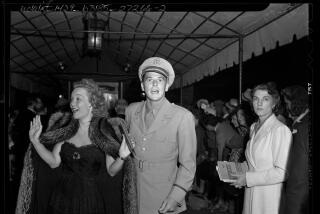An Attorney Makes the Case for Mediation
- Share via
Forrest Mosten, the 1996 recipient of the Los Angeles County Bar Conflict Prevention Award, believes the legal profession’s fate is at risk.
The current legal system is overly contentious, glacially slow, burdened with skyrocketing costs and sinking ever further in public esteem, he says. So he is helping lead a small but rapidly growing body of lawyers calling for nothing less than a revolution in the practice of law.
In Mosten’s vision, attorneys would first act as counselors helping mediate solutions. Only if that failed would they engage in traditional adversarial litigation.
Similarly, a lawsuit would become the opportunity for adversaries to engage in “a potentially transformational experience,” opening up channels of communication, he said.
*
The alternative to wholesale reform, he says, is an increasing number of Americans bypassing attorney services. Already, a 1993 American Bar Assn. study found, 62% of all divorces filed in the Phoenix area had no lawyers representing the two parties. And according to a nationwide ABA study, about 70% of individuals with identifiable legal needs never see a lawyer.
Jerry Shistac, ABA president, endorses many of Mosten’s ideas, calling them “cutting edge” and Mosten “a leader in his field.”
Barbara Stark, the attorney who heads the ABA’s family law publishing section, green-lighted the printing of a record number of copies of Mosten’s new book, “The Complete Guide to Mediation.”
And Laurie Levenson, associate dean of Loyola Law School in Los Angeles and a former criminal prosecutor, concurs that “lawyers see their job as going in and fighting every issue. But really, much of what lawyers need to do is to listen to the other side, and see if there’s any middle ground. That’s a different type of lawyering.”
Mediation will become a necessary alternative “because the court system cannot handle all cases before it. Traditional litigation takes too long and is prohibitively expensive. In the end, mediation will grow because it has to,” she said.
Despite numerous advantages, only 3% of all lawsuits now go to mediation.
The main obstacle, Mosten said, stems from the way lawyers are educated, with a stress on competitive one-upmanship instead of preventive, healing models. “The word ‘client’ is never used in law school, and the word ‘apology’ does not exist in the legal language. We study cases, not people,” said Mosten, a partner at the Mosten & Tuffias law firm in Los Angeles.
A new outlook toward mediation and new legal training are beginning to emerge. At Loyola, students take classes not just in mediation, but also in “ethical lawyering,” Levenson said. “This includes how to interview clients, counseling them on the emotional and psychological alternatives as well as the legal issues.” Such classes fill a gap in traditional legal education, she said.
The endorsement of Mosten’s views among the ABA’s upper echelons is surprising given his criticism of the way his colleagues practice law. In one of many salvos against attorneys in his book, Mosten says: “Instead of feeling that we are making a difference in our clients’ lives and to society, we often feel like hired guns who play out the family pathology.”
Too often, Mosten contends, “while the [litigating] parties are trying to make a deal, lawyers often act as the naysayers.”
Admittedly, Mosten did not always have these views. Rather, he came to them after graduating from UCLA Law School in 1972 and spending four years as a traditional family litigator.
Drained by his acrimonious practice, Mosten left the firm he co-founded, Meyers, Jacoby & Mosten (now Jacoby & Meyers), to teach at Mercer University Law School in Georgia. While there, he read about mediation and incorporated hands-on workshops into his classes.
Three years later, Mosten became assistant regional director for consumer protection at the Federal Trade Commission’s Los Angeles office. In 1980, he returned to private practice, putting mediation theory to work and concentrating on his specialty, family law.
*
Back then, largely because mediation was so little known, Mosten logged only 90 hours of mediation in the first year. Now, 75% of his work involves mediation, encompassing not only family law but also business disputes, malpractice suits, condominium battles and the like.
Mosten points out that about 95% of all cases, civil and criminal, are settled through out-of-court negotiations rather than through trial. For most litigants, then, the real choice is not whether to go to trial or negotiate, he said, it is how to negotiate: through the traditional adversarial system--with its wrecking of family, business and friendships--or through mediation.
Most lawsuits are not filed by strangers, Mosten notes. “They come from individuals who once had a relationship, where something has gone wrong,” he said. Unlike the litigator who looks to maximize his client’s benefit even at the cost of the family or business, “the successful mediator helps defuse the situation, restoring whatever was best in the relationship,” he said.
The result: Parents undergoing a divorce may still be able to work together to help, say, a child in trouble with drugs.
In a mediation, although the disputing parties may be advised by lawyers, they talk and negotiate face to face. And, unlike arbitration, mediation results are not legally binding until both sides agree to the proposed solution. Afterward, however, the results carry the full force of law.
About 90% of mediation cases achieve resolution--roughly the same percentage resolved through adversarial negotiations, Mosten said. The difference is that a mediation takes only weeks to resolve, not months or years, and costs only a third to half as much as a traditional lawsuit, he said.
Clients who opt for mediation are no “nicer” than those who go the traditional route, Mosten said. “What’s different is the process--and the results,” he said. “Mediation simply feels better. If you’re in business, you don’t have to spend as much time in your lawyer’s office.”
In mediation proceedings, offers and counteroffers may not be presented as evidence in a trial. In traditional litigation, on the other hand, all proceedings are public. “The public record is forever there for anyone to come see. Children, for example, can see what their parents said of each other.”
Traditional litigation is historically oriented, Mosten said. “You exhume the cadaver and pick what went wrong,” he said.
Mediators, by contrast, work on healing wounds and planning for the future. Thus, preventive mediation may be used to negotiate prenuptial agreements or the rules of a business partnership.
“If mediation grew to 30% of all cases, it would drive the system,” Mosten said.
Levenson, however, warned that while mediation may well work in both civil and minor criminal cases, it cannot take the place of criminal trials for more serious offenses. There, she said, the harm is not just to the victims, but to the public.
Still, she said, by freeing the courtroom dockets of an escalating backlog, mediation will free the justice system to do what it does best--try major cases.
(BEGIN TEXT OF INFOBOX / INFOGRAPHIC)
A Lesson in Listening One of attorney Forrest Mosten’s recent mediations involved a major ‘60s rock group, whose members had stopped talking to one another as they spent hundreds of thousands of dollars litigating their differences. Problems had flared again with the re-release of the group’s songs.
The ostensible problem was money, Mosten said. But when the band members got together in his office, each talked about how they had never listened to each other. One of the band members accused another of never liking his lyrics, while two others traded accusations over a romantic rivalry.
As the underlying issues surfaced during the two-day mediation, the band members lowered their voices, and a few even hugged each other. “They agreed to disagree, to find out what was workable between them, and go from there,” Mosten said.
Score another point for the power of mediation.
More to Read
Sign up for Essential California
The most important California stories and recommendations in your inbox every morning.
You may occasionally receive promotional content from the Los Angeles Times.










